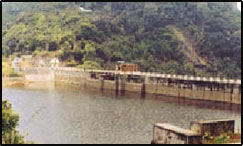|
Coimbatore is an important industrial city, which is located in the South Indian state of
Tamil Nadu. Being an important textile-manufacturing centre in India, it is also known as the 'Manchester of South India'.
There are more than a hundred textile mills in and around Coimbatore apart from a number of other manufacturing units, which
produce engineering equipment and electronic items.
 Coimbatore lies at the foot of the quaint Nilgiri Hills. Its vicinity to the Nilgiri hills gives Coimbatore a pleasant climate
that is much cooler than the coastal regions of Tamil Nadu. Travellers visiting the Nilgiri hills from the south use Coimbatore
as their base. Coimbatore lies at the foot of the quaint Nilgiri Hills. Its vicinity to the Nilgiri hills gives Coimbatore a pleasant climate
that is much cooler than the coastal regions of Tamil Nadu. Travellers visiting the Nilgiri hills from the south use Coimbatore
as their base.
Coimbatore is a part of the Coimbatore circuit covering places like Coimbatore, Mettupalayam and Ooty.
While at Coimbatore you can visit the Botanical Garden, the Agricultural College Museum and the VOC (V.O Chidambram) Park.
You can also purchase textiles and readymade garments in Coimbatore, as it is an important textile-manufacturing centre in
India.
Fast Facts
| Area |
105.60 sq km |
| Altitude |
43.2 m above sea level |
| Languages |
Tamil, English |
| STD Code |
0422 |
| State Capital |
No |
History
The strategic location of Coimbatore near the Palghat gap within the Western Ghats has made
this region an area of conflict between different southern kingdoms since ancient times. Not much is known about the prehistory
of this region. However, during the Vedic age (1500 BC-600 BC) Dravidians are supposed to have inhabited this region, like
most other areas of south India.
The region around Coimbatore was amongst the first places in Tamil nadu, where the
local Tamil speaking people set up territorial states. In the ancient period the region around Coimbatore was known as Kongu
Nadu (Kongu country) and was ruled by local Velir chiefs, who were of Tamil origin. In course of time Kongu country witnessed
a long drawn out struggle between the different kingdoms of south India: the Cholas (who ruled the area of Tanjore), the Pandyas
(who ruled in the region of Madurai) and the Cheras or Keralas (who ruled the Kerala coast). The region ruled by these kingdoms
was known as the land of the Tamils, as Tamil was the language spoken here. The information we get about these three states
is mainly based on Tamil literature also called the 'Sangam literature'.
Sangam literature is a vast collection
of ancient Tamil poems. These poems are treasure troves of information, as they vividly describe the life and culture of the
common people and the rulers of South India. These poems point out that the Cholas Pandyas and Cheras constantly fought with
each other, and the boundaries of their states changed frequently. A large part of Kongu Nadu was ruled by the Cheras while
the remaining areas was in possession of the Pandya Kings. Though the region around Coimbatore witnessed a lot of conflict
in the ancient period, in reality it never became an important centre for any kingdom and was mainly inhabited by local tribes.
This
region became a part of the great Vijayanagar Empire in the medieval period. After the disintegration of the Vijaynagar Empire
the local Nayaka rulers of Madurai ruled it. For a short period of time this region came under the rule of the Mughal Empire
when Emperor Aurangzeb annexed large areas of Southern India, during his famous Deccan campaign. However, the Mughal Empire
could not hold on to its newly acquired territories for long. The decline of the Mughal hold in this region created a political
vacuum, which led to a renewal of conflicts between different states. The British finally annexed this region in the 18th
century.
Best Season, Climate, and Clothing
The climate of Coimbatore city is moderate and pleasant throughout the year with not much
temperature fluctuations between summers and winters. Summers are hot with the maximum temperature reaching 39°C, the minimum
temperature in summer is 21°C. Winters are mild with the maximum temperature hovering around 30°C and the minimum temperature
rarely going below 15°C. Coimbatore being in Tamil Nadu, does not receive monsoon rains between the months of June and September.
However, it experiences rains in October-November, which is brought about by the retreating monsoons (north-eastern monsoon).
The best time to visit Coimbatore is between December and March. Cotton clothing is apt for summers and light woollens are
required for winters.
| 
